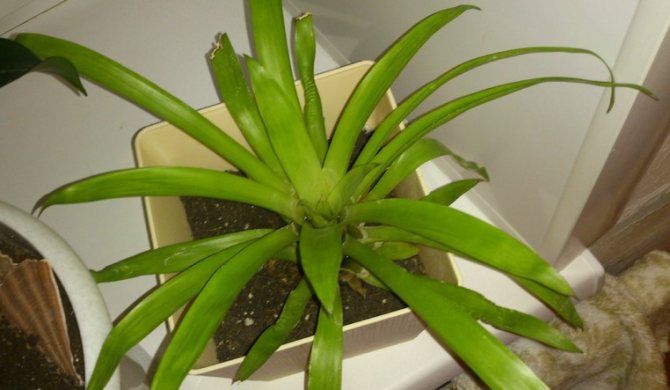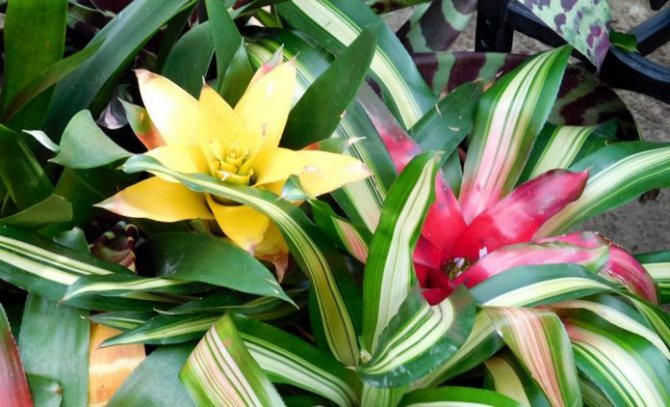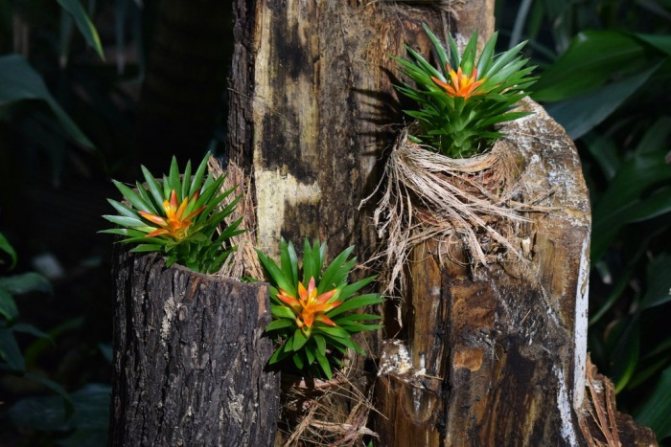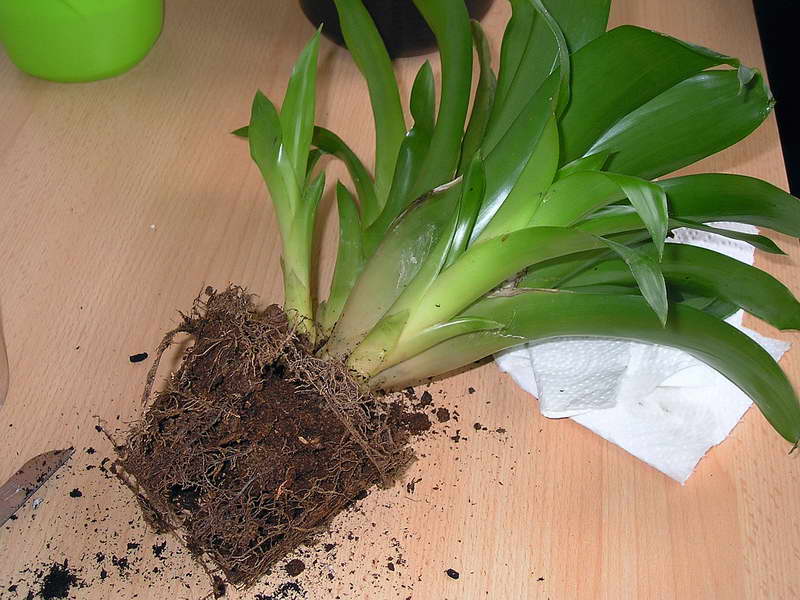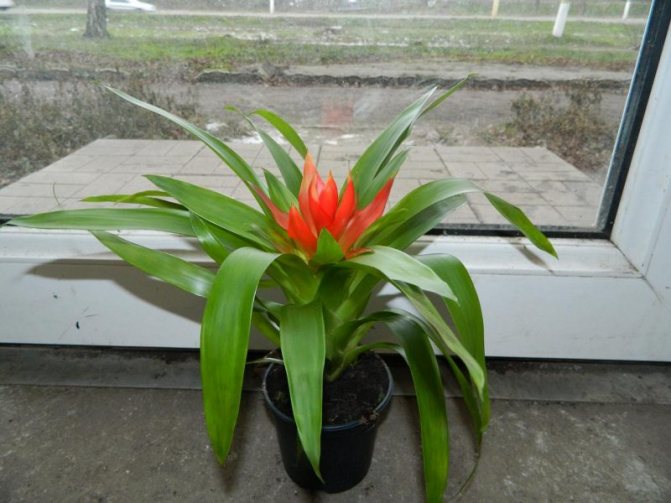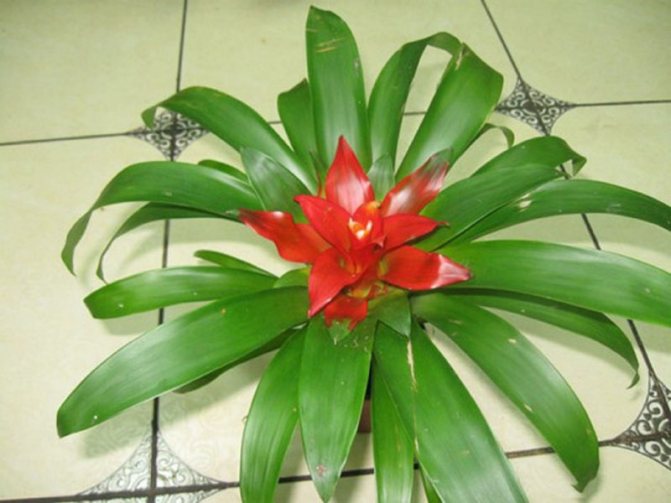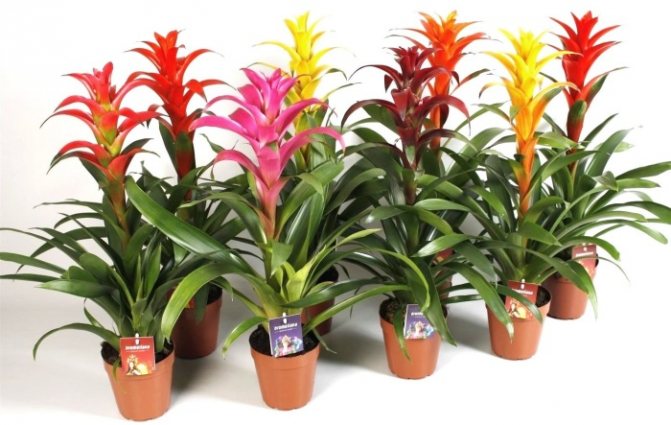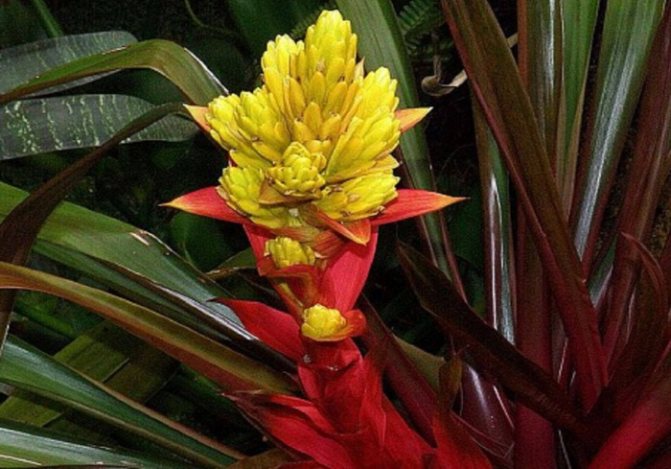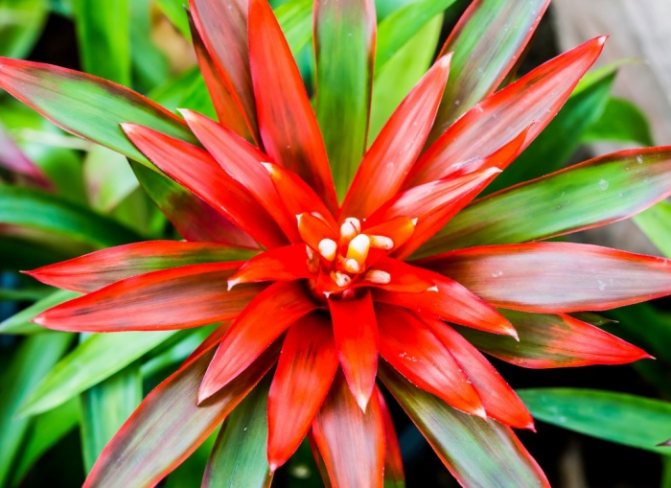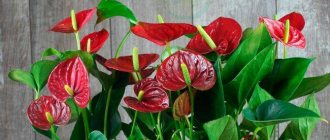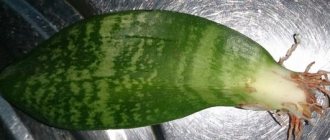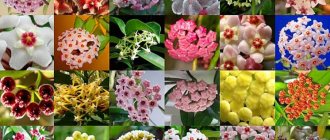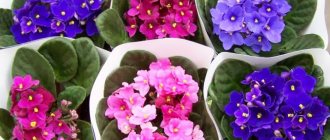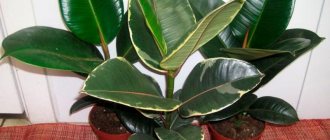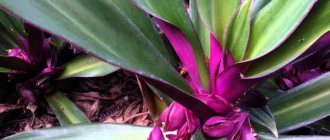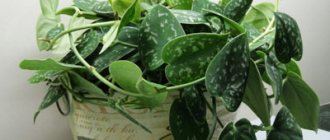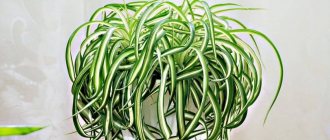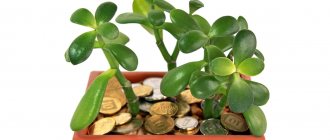Guzmania (gusmania) is a herbaceous evergreen plant, a close relative of pineapple. As an ornamental plant, it began to be grown relatively recently. It occurs naturally in the tropical forests of India and South America. Named after the discoverer - Spaniard Anastasio Guzman. Its feature is a long flowering period - up to several months, after which the plant dies, leaving children.
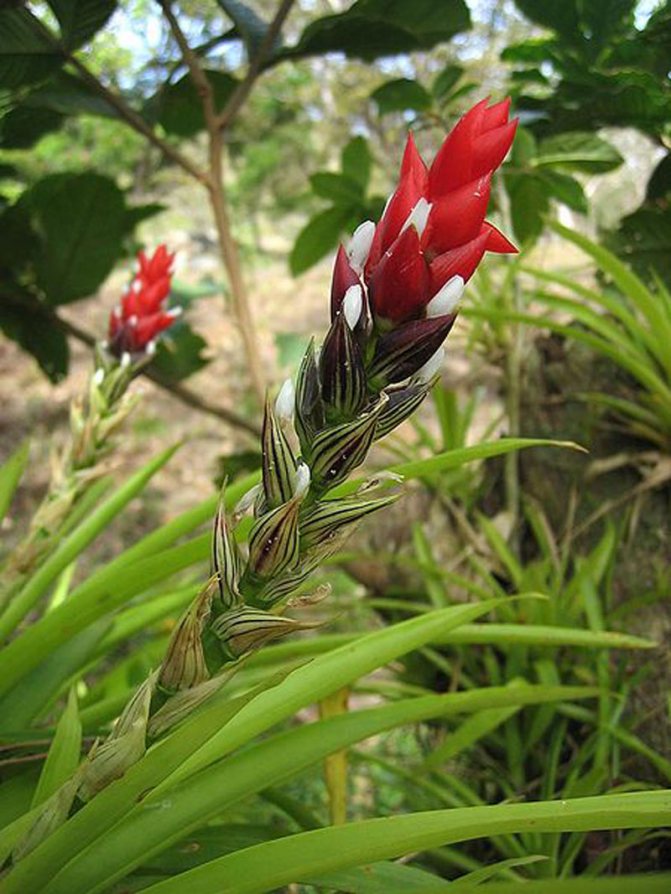
Guzmania: home care
The flowering period begins in August.
Often in a flower shop you can see the name Guzmania mix, but this is not a designation of the variety. The inscription only confirms that a mixture of colors is being sold. Having acquired such a collection, where different species bloom at different times, you can observe continuous flowering all year round.
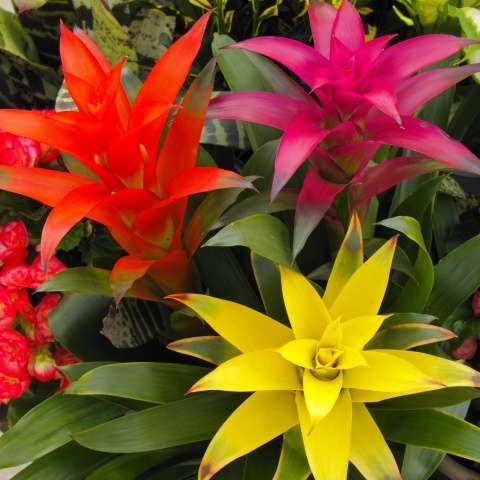

Photo: Guzmania
Content
- Listen to the article
- Planting and leaving
- Description
- Guzmania care How to care
- How to water
- Top dressing
- How to plant guzmania
- Guzmania reed
The soil
In its homeland of Central and South America, this flower grows on old trees, using their wood and bark for nutrients. Therefore, either any soil for room guzmania will not work, you need a specific one.
The easiest option is to buy a ready-made substrate, but if it does not suit you, then prepare the mixture yourself:
- buy sphagnum moss:
- take 1 part of peat;
- sand - 1 part;
- sod land - 1 part.
By mixing these components, you get soil for guzmania, but keep in mind that the pot is 1/3 filled with drainage.


Photo: Guzmania
Diseases, pests and ways to control them
Proper care of gusmania presupposes strict adherence to growing conditions. Otherwise it may cause the appearance of certain diseases:
- Fungal diseases (powdery mildew, gray rot, etc.). The reason for their appearance is associated with high humidity and air temperature. An effective method of combating them is the use of a fungicide;
- spider mites, scale insects and mealybugs.Favorable conditions for the appearance of the pests described above are low air temperature, excessive soil moisture, and the use of contaminated soil. At the first signs of the presence of pests, the plant is treated with an insecticide.
Care features
When caring for guzmania at home, the following aspects are priority:
- Lighting... Having brought the guzmania home, give her a place where she will not be in direct sunlight, which is dangerous for her, but bright. For this reason, in summer, a flower does not belong on a sunny balcony. If all your windows are sunny, then it is better to install a stand next to the window for a capricious Tropicana or shade the window with a light curtain. In winter, she will be fine at the window. If there is a lack of natural light, install a fluorescent lamp that should function for at least 8 hours a day.
- Temperature regime... Guzmania feels comfortable in tropical conditions. In summer, for normal development, she needs a temperature from 23 to 25 degrees C. Temperatures above this threshold, she can only withstand a short time. In winter, it is enough from 18 to 22 degrees C.
- Important for this exotic flower and moisture indicator at the level of 60 to 80%. The room where the guzmania is located must be ventilated, both in summer and winter. Moreover, it should be away from drafts.
- How to water... It is difficult to create ideal conditions for guzmania, except to place it in a bathroom, where the humidity is always high. But there is another option - periodic wiping of leaves, spraying. Water the tropicana in the summer almost every day, as soon as the substrate dries up. In autumn and winter, if the room is not higher than 20 degrees, one or two waterings per week are enough.
Keep in mind that in summer not only the soil is watered, but the rosette formed by the leaves must be constantly filled with water. This water must be drained monthly and the funnel filled with fresh water. Requirements are also made to the quality of water: it must be defended, hard, cold water is not suitable. Ideal when the water temperature is slightly higher than the air temperature in the room.
Dangerous for the flower and excessive moisture. If you water it too intensively, the roots may fester or fungal diseases may develop.
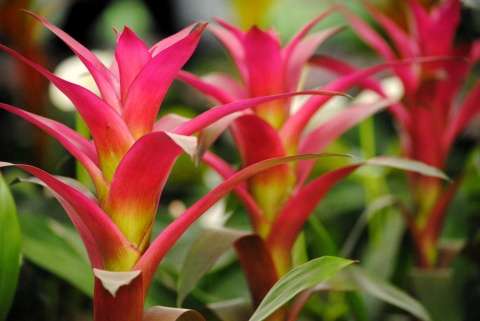

Photo: Guzmania
Flowering and dormant periods
If guzmania does not please you with its beautiful flowers, then most likely it is kept in conditions that are not suitable for it. The air in our apartments is dry: it is necessary to spray the plant more often. Also, watch the position of the potted flower: it may be hot, move the plant to the west or east side.
Do not forget about the nutrition of your "green friend": feeding within reasonable limits during the growing season helps to form the long-awaited peduncle. This can also be facilitated by a simple apple placed in a plant pot for several days. Wrap the fruit in a plastic bag; it will release substances capable of awakening a dormant flower bud. Make sure that the apple does not start to rot; in this case, change it to a fresh one.
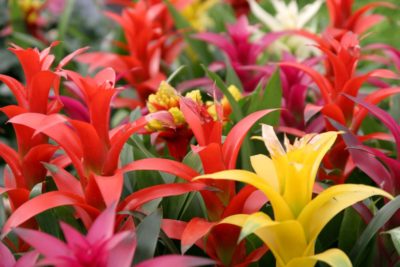

If you follow all the instructions described in the article correctly, then the beautiful southern guzmania will definitely settle in your house for a long time and will delight you with beautiful flowering.
The most crucial and difficult period in the life of a plant is the flowering time. The first bracts in Guzmania appear only in the third or fourth year of development. Flowering continues for several months, but only in favorable conditions. As soon as the shade of the foliage of the guzmania changes or a green peduncle begins to slowly rise from the outlet, this is the very moment before flowering.
The plant does not have a pronounced dormant period.The flower does not shed its leaves, the lighting requirements do not change. He only needs to lower the temperature of the content, reduce watering and stop feeding.
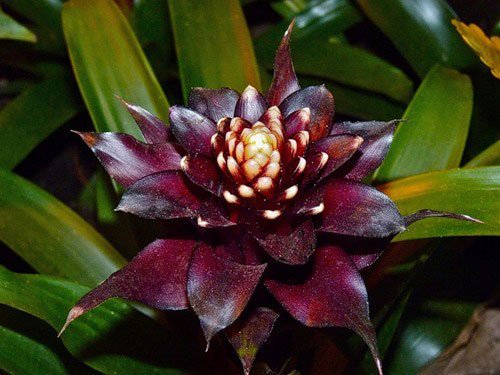

The flowering of guzmania is a clear sign that the flower is completely satisfied with the conditions of maintenance and care provided by the florist
There is a trick that allows you to bring the moment of blooming guzmania closer. To do this, place a container with chopped apples, pears or bananas next to it and cover the entire "composition" with a plastic bag. During the decomposition of the fruit, ethylene is released, which stimulates flowering. You just need to be careful not to allow the appearance of mold, which can provoke the development of rot.
Care Tips
- If you notice limescale on the leaves, then this means that you have very hard water. Use a rain or well-filtered one.
- When the leaves begin to brown at the tips, the room is too dry. Spray your guzmania as often as possible.
- Pale brown spots on the leaves indicate that the plant is being exposed to direct sunlight. Take it to a safe place immediately.
- When flowering is complete, cut off the peduncle. It prevents new outlets from appearing.
- Oddly enough, this plant grows best in an aquarium with wet sand at the bottom. When the air in the room is very dry and even frequent spraying is not effective, this is the only way to save the flower from drying out.
- Guzmania needs to be fed, but only from May to early September. Use a bromeliad fertilizer found at your flower shop. If you buy an ordinary universal fertilizer, then make sure that, firstly, it contains as little nitrogen as possible, and secondly, reduce the dose recommended for other indoor plants by 4 times.
That's all about caring for the bromeliads. It should also be started because, according to scientists, it has a very beneficial effect on the atmosphere in the house.
Bromeliad family. Homeland of the rainforests of South America. The genus includes about 130 species of epiphytic plants. A fairly common plant, which is appreciated by lovers of bromeliads for their gorgeous inflorescences. Guzmania grows strongly in width, therefore it requires a lot of space, it is best to place it on a separate stand next to the window. Otherwise, look after other bromeliads.
Tips & Tricks
A mandatory event that should accompany the indoor cultivation of guzmania mix is the timely and competent transplantation of an exotic plant into a shallow flower pot filled with a high-quality and well-drained substrate. The plant purchased from the flower shop also needs to be transplanted after purchase.
It is recommended to replant young ornamental crops annually, in early spring, before the flowering of the indoor plant. You can transplant adult plants every two or three years, in the spring-summer period, with an annual touch-up or addition of the substrate. Transplanting gusmania must be done very carefully and carefully, due to the presence of a very delicate and vulnerable root system in the plant.
Types of guzmania
Especially popular is Guzmania lingual Guzmania lingulata - its leaves are lanceolate, on average 25-40 cm long and 3-3.5 cm wide. The peduncle reaches 30 cm in height. Yellowish-white flowers peep out of bright red fused petals in the center of the inflorescence. There are a few, only three registered variations, all different from those described - just clones of one variation or another.
- Guzmania reed purple Guzmania lingulata var. cardinalis - a variation with a wide rosette of green leaves 3-4 cm wide, with a multi-flowered inflorescence, bracts are scarlet, red, purple;
- Guzmania reed modest-colored Guzmania lingulata var.concolor - compact variation, rosette of light green leaves, faded orange bracts with brighter tips, inflorescence up to 15 cm in height;
- Fire guzmania Guzmania lingulata var. flammea - green leaves about 25-30 cm long, 1-2 cm wide, leaves stick up, has fiery red bracts, small-flowered inflorescence;
Guzmania reed Guzmania reed Guzmania blood-red
Guzmania blood-red Guzmania sanguinea - unlike the previous species, it has wider leaves, 5-6 cm wide, up to 35 cm long. At the time of flowering, the pericolor leaves are red-brown with longitudinal purple spots. The inflorescence is a brush, but it does not rise on a long peduncle, but remains in the center of the rosette of leaves. Bracts are short and thin, 1.6 cm long and 1.5 cm wide, tubular yellow-orange flowers 5-6 cm long. It is rarely found on sale.
The two species have some differences: in blood-red gusmania, a little water should remain in the outlet, about 2.5 cm.In gusmania, the reed outlet is loose, almost all the water flows into the soil, but some remains in the leaf axils. It is necessary to water only in the lower leaves, but not in the place from which the peduncle grows. Since the reed gusmania very often have loose rosettes, they almost do not hold water, there is a threat of waterlogging of the soil, so the soil for them must be very loose. It is better to periodically loosen it near the walls of the pot, or make holes in the pot only at the bottom, but also on the side.
Characteristics and description of the plant
Guzmania is an ornamental houseplant with a height of about 20-30 cm. Its leaves fit tightly to each other, forming a bowl-shaped rosette at the base. It accumulates water necessary for the growth of the flower. The color of the leaves is dark green, almost always monochromatic. Sometimes there are specimens with variegated colors, striped leaves. The root system is weak, serving only for attachment to the ground.
Guzmania blooms for a long time - at least three months. Its bright inflorescences in the form of a magnificent sultan are red, pink, orange, and can have shades of crimson or yellow. After flowering is complete, the maternal process dies off, leaving 5-6 babies in the pot. Before you plant them, you need to study some rules. Although this flower is considered unpretentious, it has enough nuances of watering and transplanting.
Advice! Before buying this flower in a store, you should study the conditions for caring for it. It is advisable to transplant it into another pot immediately after purchase, to create suitable conditions for temperature and watering.


Gusmania care
Temperature: Guzmania is thermophilic. The usual room temperature in summer is about 22-28 ° C, in winter it is cooler than 18-20 ° C, the minimum winter temperature is 18 ° C.
Lighting: light partial shade, with mandatory protection from direct sunlight from 11 to 15 hours. In the spring and summer, the best place for gusmania is the sill of the east window, or in the immediate vicinity of the south or west window. In winter, you need a bright window without shading (until mid-February).
Watering: like all bromeliads, gusmania is watered directly into the leaf outlet, part of the water flows into the ground, and watered again only when the substrate in the upper part dries out. The water must be soft (preferably boiled) and at room temperature. In spring and summer, water should always be in the leaf outlet, and is renewed at least once a month with fresh water. In winter, gusmania is watered very carefully so that the soil dries out to half the height of the pot.
Top dressing: from May to August, fertilizer dressings are carried out once a month, while the fertilizer is diluted with water for irrigation and poured into an outlet. Fertilizer is used special for bromeliads or for common indoor plants, but taken in a dose four times less than for other plants.The NPK ratio in the fertilizer should be approximately the same, in equal proportions.
Humidity: Gusmanias like regular spraying, which is necessary if the plant is in too warm a room (with central heating in winter). But you can put the pot on a wide tray with damp sphagnum moss.
Transplant: usually carried out after the end of flowering, when the mother plant dies off and the babies grow up. Gusmania is planted in a soil mixture consisting of 1 part light leafy earth, 1 part coconut fiber (coconut chips or coconut substrate), 1/2 part pine bark pieces, 1/2 sand or vermiculite, here you can add a handful of chopped dried moss - sphagnum. You can use a commercial bromeliad potting mix. The planting container should not be too deep, it is better to use wide bowls. You can make up a soil mixture based on a store-bought soil, for this, use a universal soil (for example, terra-vita), add pine bark to it, broken into fractions of about 1 cm, coarse sand sifted from dust, all in equal parts. Sand can be replaced with vermiculite. Add a few pieces of birch charcoal. There is drainage at the bottom of the pot, made of expanded clay or pieces of wine cork.
Planting guzmania (personal experience, severin): As a substrate for bromeliads, you can offer several options:
- a mixture of semi-decomposed leaves, sphagnum, peat, sand, pieces of charcoal or broken shards
- litter of conifers mixed with peat in a 1: 1 ratio
- pine bark mixed with peat in a 1: 1 ratio.
How to transplant gusmania (video)


Gusmania care does not imply frequent transplants. Guzmania does not need such a procedure if it feels great: the leaves are green, the roots are healthy, the growth dynamics is visible. A transplant is needed only when urgently needed - for reproduction, when children are formed, or to change the pot, if it is frankly small. In this case, you need to take into account some of the nuances.
Guzmania is an epiphytic plant, so it needs the lightest substrate. Under natural conditions, it grows on the bark of trees or on the forest floor, and feeds on moist air.
If we are talking about a self-compiled soil mixture, then it should be peat, river sand, turf and humus in equal parts, where you need to add sphagnum and crushed pine bark (as drainage). Of course, it is easier to purchase special soil for bromeliads in the store.


The substrate for guzmania should be light and loose
Pot
A bowl for guzmania is chosen deep, but not wide. In this case, the roots will not rot, they will develop correctly, providing the plant with sufficient nutrition. It is better to opt for a small pot, always with drainage holes. For stability, it is recommended to put something heavy on the bottom of the flowerpot.
Do not think that all exotic plants require any special care. Guzmania, without causing much trouble, will delight you with splendor and bright colors.
The exoticism of guzmania is manifested even in watering. This process does not take place, like in most plants, under the root, but by filling the outlet with water. And all due to the fact that in its natural habitat, the guzmania collects moisture mainly from the atmosphere thanks to its wide leaves, which serve as a kind of troughs for the accumulation of water. If the air in the room is dry, the flower should be sprayed at least once a day.
Watering is done in this way. They take settled water at room temperature and carefully pour it into the center of the outlet. At the end of the day, the excess water is drained off. This is between April and September. In winter, when the temperature drops to 18 ° C, the soil is moistened in the traditional, root way. This is due to the fact that under such conditions there is a risk of developing fungal diseases.Watering is carried out every day in summer in hot weather (when it is cloudy, it can be done every other day).
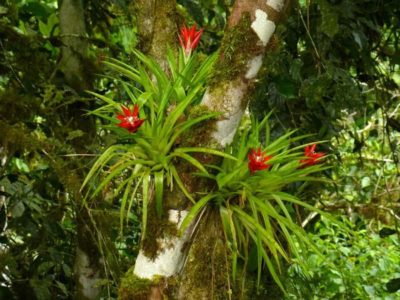

In nature, gusmanias take moisture from the air, so watering them at the root is not enough and not always necessary
Spraying guzmania is carried out every day with warm water (about 30 ° C). Cold water cannot be used for these purposes - dark spots will appear on the leaves.
Top dressing is an important point in plant care. Fertilizer is suitable for bromeliads. It is bred according to the instructions and sprayed with guzmania once every two weeks in the summer, and in the spring and autumn - once a month. In winter, feeding is not needed.
Flowering period
Flowering is the brightest period in the life of Guzmania, but also sad, since after that the plant dies off. The exotic beauty blooms for about 17 weeks. Rather, this bract is pleasing to the eye, and small flowers fade a couple of days after emergence. Usually in stores you can buy already blooming guzmania. The question is, how long has she been in this state and whether she will have time to raise children for later life.
After the guzmania has faded, the peduncle should be cut out at the very base. This is done so that, firstly, the plant no longer wastes energy on unnecessary objects, and, secondly, to give an aesthetic appearance.
What to do when the plant doesn't want to bloom? It seems that the conditions for her are the best, but for some reason the guzmania does not release a peduncle. In this case, it is necessary:
- Provide a sharp rise in temperature to 27 ° C for a couple of days - you can cover with cellophane, and then lower it again to 24 ° C.
- Grind bananas and apples into a bowl, place next to the guzmania and cover the entire structure with a bag. The fact is that fruits secrete special substances that accelerate ripening, and also have a beneficial effect on the beginning of flowering. Until the bracts appear, the bag is not completely removed, but periodically the fruits are replaced with fresh ones so that rotting does not begin.
Guzmania after flowering
Guzmania blooms only once in a lifetime, but at home it can grow for several years before flowering. Lateral cuttings appear during the entire growing season, and sometimes just before flowering. In this case, until the "mommy" fades, the children do not need to be removed, the children are removed when they grow up to half their maternal height. Sometimes the daughter rosettes appear one after the other, but flowering does not occur. Perhaps the plant is uncomfortable - not enough humidity, too dark or too dense nutritious soil.
Reproduction: lateral shoots, which are cut off after they have grown their roots. It is also propagated by seeds, which are sown in loose soil (a mixture of vermiculite and leafy earth in half). The sowing dish should be placed in a warm place at 24-25 ° C, sprayed daily and ventilated. Gusmania seeds germinate in 12-20 days.
Seedlings must be placed on a light window or supplemented with lamps. You can use fluorescent lamps, placing them above the plant at a distance of 10-20 cm, turn on for 10-12 hours a day. Plant young gusmanias in separate pots about 2 months after germination. Remember to sterilize the soil and add a piece of birch charcoal to it.
Reproduction
Reproduction of Bromeliads at home is not difficult, but requires a fair amount of patience. For breeding guzmania, children or seeds are used.
Babies begin to form with the onset of flowering. By the time the mother plant dries up, they usually have 3-4 leaves and a well-developed root system. Daughter rosettes are cut, trying not to "tear off" the roots, placed in a mixture of peat, sphagnum and sand; keep warm until they take root. They bloom for 4-5 years of life.Flowering can be accelerated by leaving one "daughter" on the mother bush, cutting off its dried aerial part. In this case, a young plant can bloom next year.
If you decide to propagate guzmania by seeds, do not remove the peduncle and wait until they ripen. The seed is sown immediately after collection in a mixture of peat and sand. Before planting, it is advisable to spill the substrate with potassium permanganate for disinfection. Seeds are spread over the surface without sprinkling. The containers are placed in a greenhouse. It is important not to allow the topsoil to dry out by regularly moistening it with a spray bottle. At a stable temperature of 25 degrees and the presence of bottom heating, the seedlings hatch after 3 weeks. After another month, they are seated in separate containers.
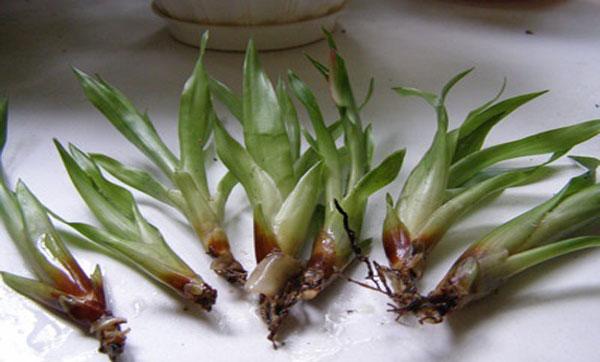

Guzmania pests
- Bromeliad scale - settles on both sides of the leaves, similar to brown, sometimes almost black, plaques-tubercles. Affected leaves turn yellow and die off. Take a close look at the plant in the store! Control measures. Pests are removed from both sides of the leaves with a sponge dipped in an insecticide solution (actellik 15-20 drops per 1 liter of water), or the plant is sprayed with the same solution. You can water the ground with a solution of systemic insecticide actara.
- Mealybug - pests are white, shaggy insects, do not fly, concentrated mainly at the base of the leaves, in the root zone. The mealybug damages the leaves, and a sooty fungus settles on its secretions. The plant lags behind in growth, the leaves turn yellow, if you do not take action, the plant may die. Control measures. Use a sponge with laundry soap or alcohol to wipe off all leaves on both sides. Water the ground with a solution of the systemic insecticide actara or confidor.
- Spider mite - yellow spots of irregular shape appear on the leaves, and puncture points are visible in the lumen of the leaf. The leaves gradually turn yellow and die off. Control measures. Wipe all the leaves with soapy water, then spray the plant with acaricide (sunmite, nissoran, oberon).
These babies are separated when they grow about 8-10 cm in height.
Guzmania is a plant of the bromeliad genus. Caring for this species is quite simple.
Common growing mistakes
Direct sunlight in summer is detrimental to many plants, including Guzmania. She can easily get burned if you keep her on the south window all day without shading.
If the air around the plant is too dry, especially in winter, when the heating devices are working, the tips of the leaves turn brown, curl and dry. It is necessary to constantly spray the flower and the surrounding air from a spray bottle.


Direct sunlight and dry air are detrimental to guzmania
Guzmania grows in those areas where the water hardness is very low, and the flower reacts sharply negatively to what flows from the water supply system, an ugly white coating appears on the leaves. It is important to defend the water by adding calcium, chlorine and fluoride compounds, apple cider vinegar or citric acid to neutralize it, pass it through a filter or boil it.
When the substrate for guzmania is chosen incorrectly, bays are the most common cause of flower discomfort.
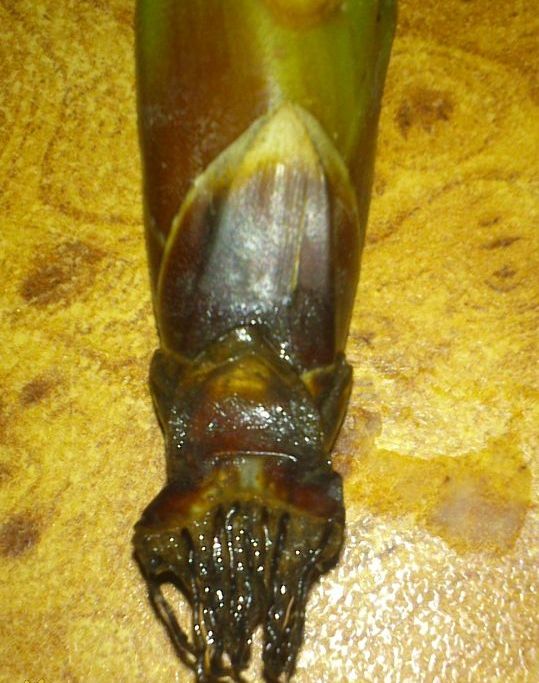

Due to excessive watering, rot quickly develops; most often the plant affected by it can only be thrown away
Novice flower growers mistakenly assume that a tropical epiphyte will thrive in ordinary flower soil. As a result, the roots of the guzmania cease to breathe in a stuck together wet earthen coma and rot.
Most often, mistakes in growing and transplanting are made by beginners who first bought guzmania or received it as a gift. Many unpleasant consequences can be avoided if you study the problems in advance, correct the wrong actions for watering or care.
Here are the main mistakes and how to fix them:
- The plant does not bloom. This means that he lacks watering, light and heat.It is necessary to put the pot in a more illuminated place, providing the desired humidity and temperature.
- The flower began to rot. The main reason for this is overflowing, stagnation of water in the outlet and sump. Watering, especially in winter, should be reduced.
- Guzmania dies. If the temperature in the room stays below 12-13 degrees for some time, this can lead to the death of the shoot.
- The flower quickly faded. If, during spraying during flowering, water droplets fall on the inflorescences, this leads to faster flowering.
- For a long time, the stem does not increase in growth. The reason is in watering conditions. The water should be free of lime and chlorine, always at room temperature or slightly warm. It is advisable to defend it.
- Children are not accepted. This means that their root system was not formed, the maternal process was removed early.


Advice! If the tips of the leaves dry out, more frequent spraying is necessary. You should remove the plant away from the battery, purchase a humidifier for a too dry room.
We suggest you familiarize yourself with: Kettle burned out how to clean
Subject to all these simple recommendations, the guzmania will delight its owners for a long time with bright inflorescences, a beautiful appearance of the flower.
Material updated on 22.06.2017
How do I transfer after purchase?
The procedure will require the following resources:
- Land for orchids or bromeliads;
- Coal;
- Landing container;
- Expanded clay;
- The plant itself.
The standard transplant procedure is as follows:
- A low pot with increased width is required. This is necessary because of the specificity of the plants of the bromeliad family. They are distinguished by a superficial root system. That is, it grows in breadth rather than in depth. Therefore, you should not choose a deep container, as the roots will not grow over its entire surface. This will provoke the formation of rot in the ground;
- A drainage layer is placed at the bottom. Its volume is one third of the height of the container. To create a drainage system, charcoal, expanded clay, and polystyrene are used. Why is the addition of charcoal important? It is a prevention of an increase in the acidity of the earth, prevents the appearance of infectious processes. The plant needs to be watered abundantly, which entails the risk of moisture stagnation. Stagnation leads to the appearance of rot. The drainage system prevents these processes;
- It is necessary to choose the right soil that is suitable for this particular plant. For guzmania, a mixture for bromeliads can be used. It includes loose leaf land, peat, bark. Orchid products can also be used. To increase its friability, you can add needles of needles, as well as charcoal to the finished mixture;
- First, the earth is laid in the pot, and then, on top of it with a layer of a couple of centimeters, the earthen mixture. An elevation must be performed in the center;
- A plant is placed on the completed elevation. Its roots straighten out. It is required to carefully add earth. During the procedure, tapping is made on the edges of the container, as this contributes to the dense packing of the mixture. The earth is poured up to the neck of the flower. After that, you need to hit the container several times. It is impossible to compact the soil strongly, as it must be loose;
- Guzmania is installed in a warm room with moderate lighting and no drafts. She loves high humidity, and therefore the air at the place of installation must be appropriate. To maintain the required humidity level, the container is placed on a pallet moistened with expanded clay. Watering is carried out in the sockets of the sheet plates. This will require soft water. Do not use cold water.
The procedure is simple enough. You can transplant this species at home without using many resources. It is enough just to purchase a pot, as well as a soil mixture.The drainage system is another important indicator that will prevent the occurrence of problems in the future.
Popular species in floriculture
- Guzmania today has more than a hundred different species. However, only a few varieties are grown at home.
- Tempo. This species attracts with its contrast: against the background of delicate, light green leaves, a bright red bract stands out favorably. Leaves are elongated, shiny, dense rosette. Height about 35 cm.
- Ostara. It's a hybrid. It has narrow, bright green leaves. The stem is long, it has scarlet bracts, white flowers appear a little later, fade quickly. Unpretentious care. Widespread among florists.
- Reed. Perhaps the most popular species among Guzmania. The rosette is dense, the leaves are wide, the perianth is bright, from scarlet to yellow. The flowers are small, cream-colored, collected in inflorescences, spikelets, do not bloom for long. Reed guzmania has varieties: purple, fiery, small, modest, ordinary.
- Minor - Rondo. A beautiful small plant, green leaves, erect bracts, red, small, white flowers, in large numbers, collected in inflorescences. Flowering begins in February.
- Calypso. This is one of the finest types of gusmania. The rosette is loose, collected from narrow leaves of light green color, the bract is erect, its leaves are directed upwards, have a bright red color.
- Blood red. A distinctive feature of this species is that the very middle of the outlet is bright red. The central funnel is often almost completely filled with moisture. Therefore, the flowers of the plant literally float in it.
- Mosaic. The peduncle itself is short, the bract consists of small leaves, painted in red or orange. The decorative value of this species lies in the leaves - they have a striped color.
- One-headed. Absolutely unremarkable, small bract. This type of gusmania has decorative long leaves painted in longitudinal stripes.
Photo gallery: types of gusmania
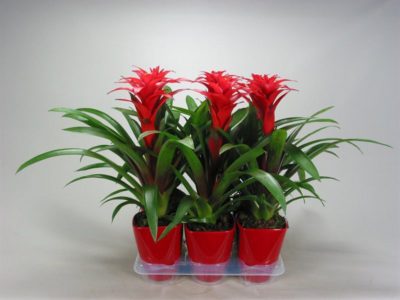

Calypso is one of the finest species of guzmania
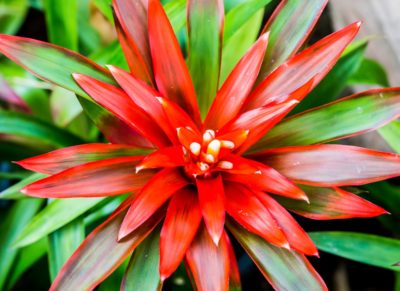

In the blood-red gusmania, during flowering, not only short bracts change the hue, but almost the entire rosette


Bracts of Guzmania Minor erect, red
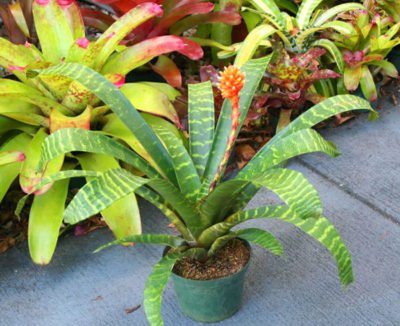

Mosaic gusmania is distinguished by dense foliage with transverse stripes One-spiked gusmania got its name due to the external features of the inflorescence
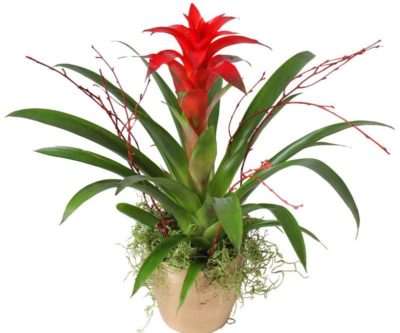

The white flowers of the Ostara Guzmania fade very quickly
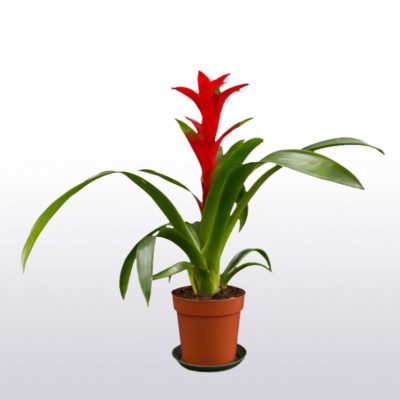

The height of the Tempo guzmania can reach 35 cm
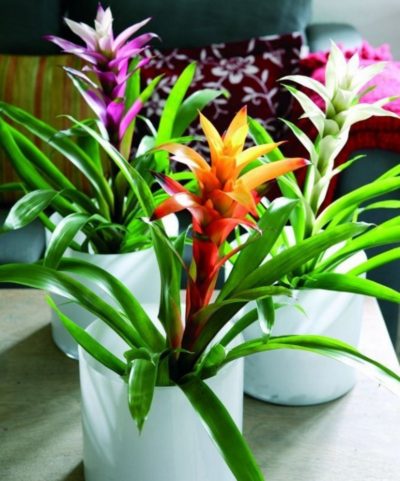

Guzmania reed - the most popular
Correct transplantation of plant babies
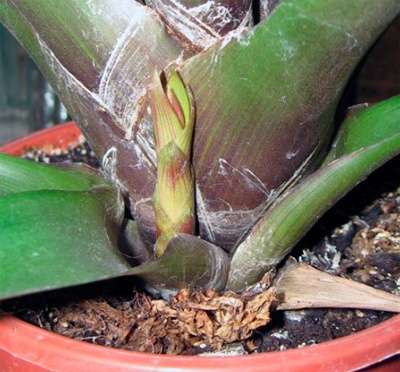

The formation of children occurs during the flowering of the maternal guzmania. They are converted to separate species. Growth occurs gradually. Separation from the main bush is performed when they reach 15 cm. During this period, children usually have 3-4 leaf plates, a formed root system. There are usually quite a few of them. The emergence of just one process is extremely rare. Usually, upon reaching such growth, the mother species dies.
Its withering sets in. During this period, it is required to cut the peduncle if seeds do not form on it. After that, it remains to wait for the sufficient growth of the baby. Its formation can be stimulated. To do this, the pot is moved to a location with sufficient shade. Watering is not carried out, as this can lead to putrefactive processes. The formation of the root system of the shoots should be monitored regularly. To stimulate its formation, it is required to dig in the ground around. The growth of children is carried out over a period of 2-4 months. The transplant can only be performed if the children already have an autonomous root system. If it is not there, the plant will simply die.
The procedure is performed as follows:
- It is better to plan it in the spring. Guzmania is taken out of the pot. The baby is separated from her.This can be done with a sharp knife;
- For soil, you can mix peat, sand, sod soil, sphagnum moss. A mixture for bromeliads, which is purchased at a specialized store, is suitable;
- The sprouts are planted in a wide variety of pots. They don't have to be deep. A drainage layer is placed in the container, then the soil. After this, children are transplanted.
The whole process requires extreme care. It is important to avoid damage to the weak root system.
How to separate the children of Guzmania (video)
Even exotic epiphytes can be successfully grown if all the rules are followed. The features of growing guzmania are already partially described above, but it is worth talking about how the reproduction is carried out by children. Botanical feature - the dying off of the mother plant after the full maturation of the "baby". At its core, this is a new bush that begins to grow nearby during the formation of the peduncle.
As soon as flowering ends, the main plant begins to dry out, giving way to a new one. The florist can only remove the dried leaves. In this state, guzmania at home can be grown for several years. In the event that 2 children have formed, one must be transplanted into a separate pot.
For this, a special soil is prepared, 2/3 consisting of tree bark, sawdust and small pebbles. You can also add sphagnum, construction or river sand, broken brick. The more structured and light the soil is, the faster the plant will develop. In some cases, it is better to purchase a special soil for bromeliads at the store.
When planting or replanting, the roots should be carefully placed in a shallow pot and sprinkled with soil carefully. From above, the soil is slightly compacted and watered abundantly. After this procedure, the plant should be placed in the shade for 10 days and the foliage should be sprayed with water 4-5 times a day.
To obtain a peduncle, it is important to maintain an optimal balance of organic and mineral fertilizers in the soil. Top dressing begins in the first decade of March and continues until the end of September. Recommended schedule: once every 2 weeks with an organic solution and once every 2 weeks with a mineral complex. Foliar dressing gives the best results. For this, the prepared warm solution is poured directly into the leaf outlet.
Do not be discouraged if flowering does not come for a long time. Usually bromeliads bloom 4-5 years after planting. After a bright climax, the plant dries up. Repeated flowering is not observed. To speed up flowering, many growers use a simple and effective technique. An apple cut into quarters is placed in a plastic bag (directly on the soil next to the plant) and the guzmania is covered with this bag. A month later, the plant blooms due to the impact of ethylene secreted by the apple.
Gusmania mix quite often suffers from damage by various fungal diseases, which are provoked by increased humidity and high temperature levels in the room. In addition, the ground part of the guzmania can be damaged by such common plant parasites as scale insects, spider mites and mealybugs, which are common in indoor floriculture. When the first signs of damage are detected, treatment is carried out with modern insect-fungicidal agents.
Signs and superstitions about guzmania
In many countries, a tropical beauty is loved not only for its high decorativeness. She is credited with the ability to create a powerful positive aura around herself that attracts happiness to the house. According to popular beliefs, guzmania helps to strengthen and harmonize family relations, enhances the sexual activity of men. Therefore, it is often placed in bedrooms, closer to the bed.At home, guzmania symbolizes harmony and prosperity; it is believed that she brings peace of mind to the owners.
Frequently asked questions about growing guzmania
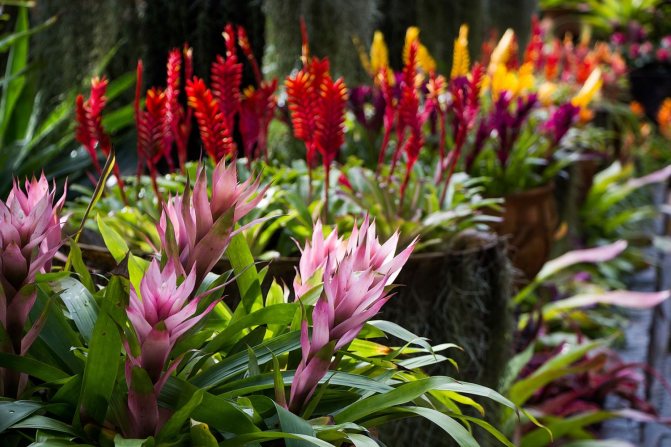

- Why is Guzmania not growing?
If you keep a plant in the same pot without fertilization for many years, then it is most likely suffering from a lack of nutrients. This applies to both "children" and adult plants. Incorrect conditions of detention may be another reason. It is possible that the plant has grown and is simply preparing for flowering and reproduction. Take your time, everything has its time.
- Why doesn't Guzmania bloom?
As mentioned above, the reason for this is a lack of light, moisture or fertilizer. Experiment with the conditions, and in a month and a half the plant will delight you with a beautiful flower.
- Why do Guzmania leaves wither?
Either you overdid it with watering, or you overexposed the plant to the light. Pests can be another reason.
The leaves and flowers are not poisonous, but it is worth avoiding contact with the milky juice on the skin and mucous membranes, as it can cause either irritation or an allergic reaction. In general, the plant is quite safe if you have children or dogs and cats.
Related entries:
Category: Bromeliads

